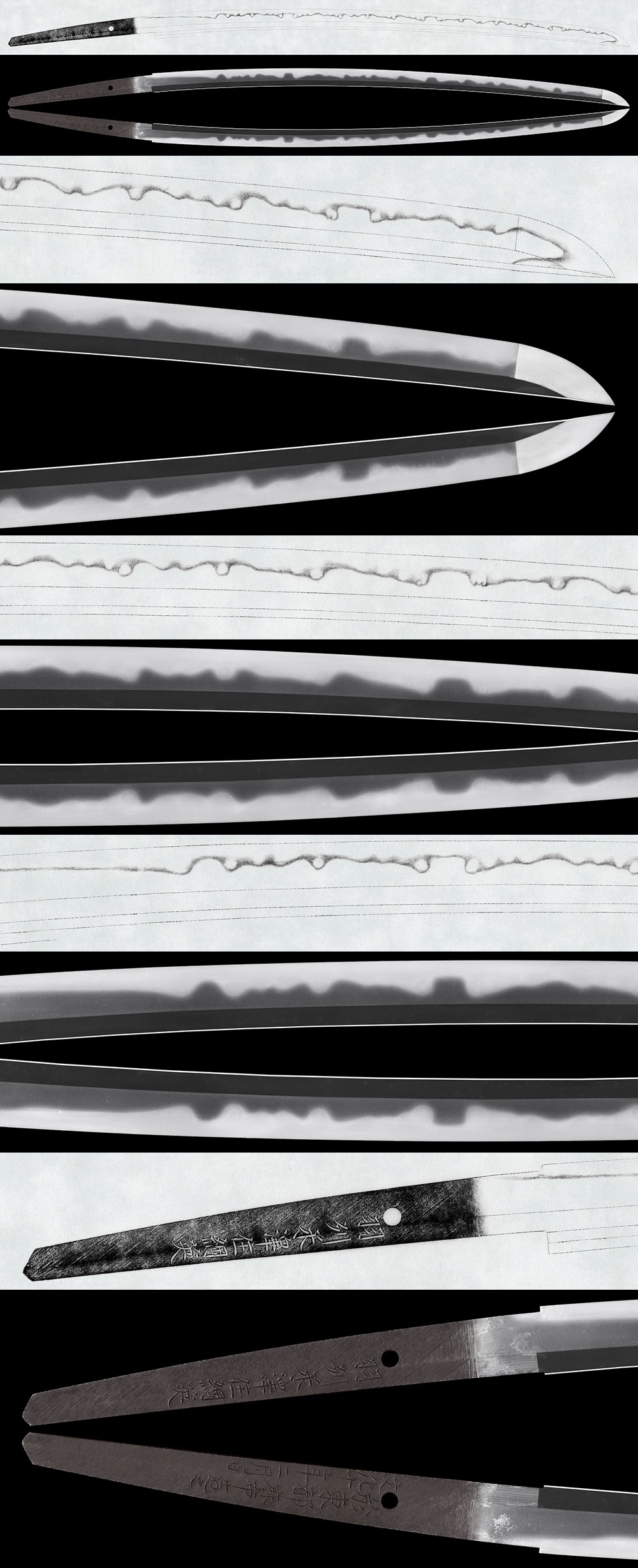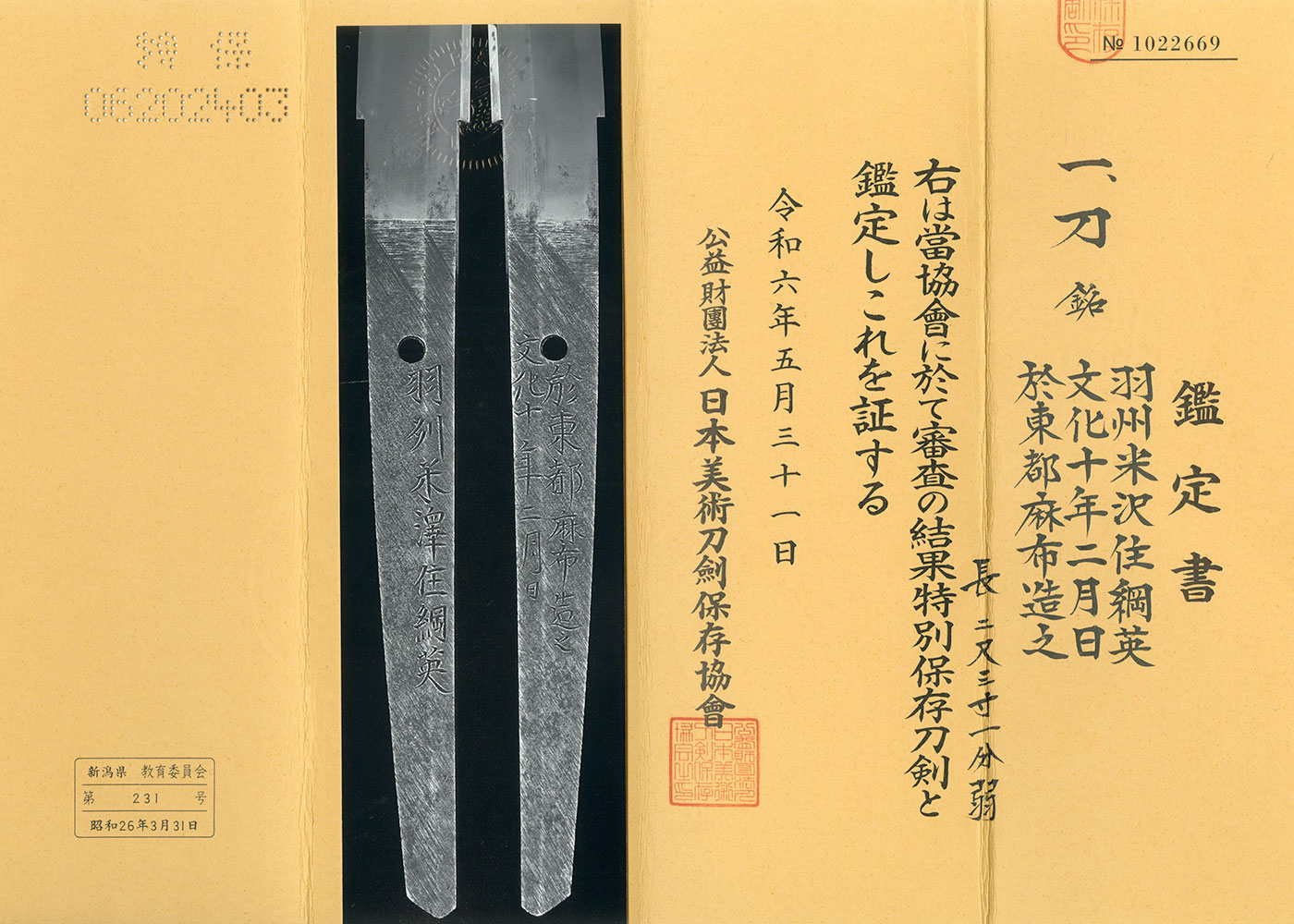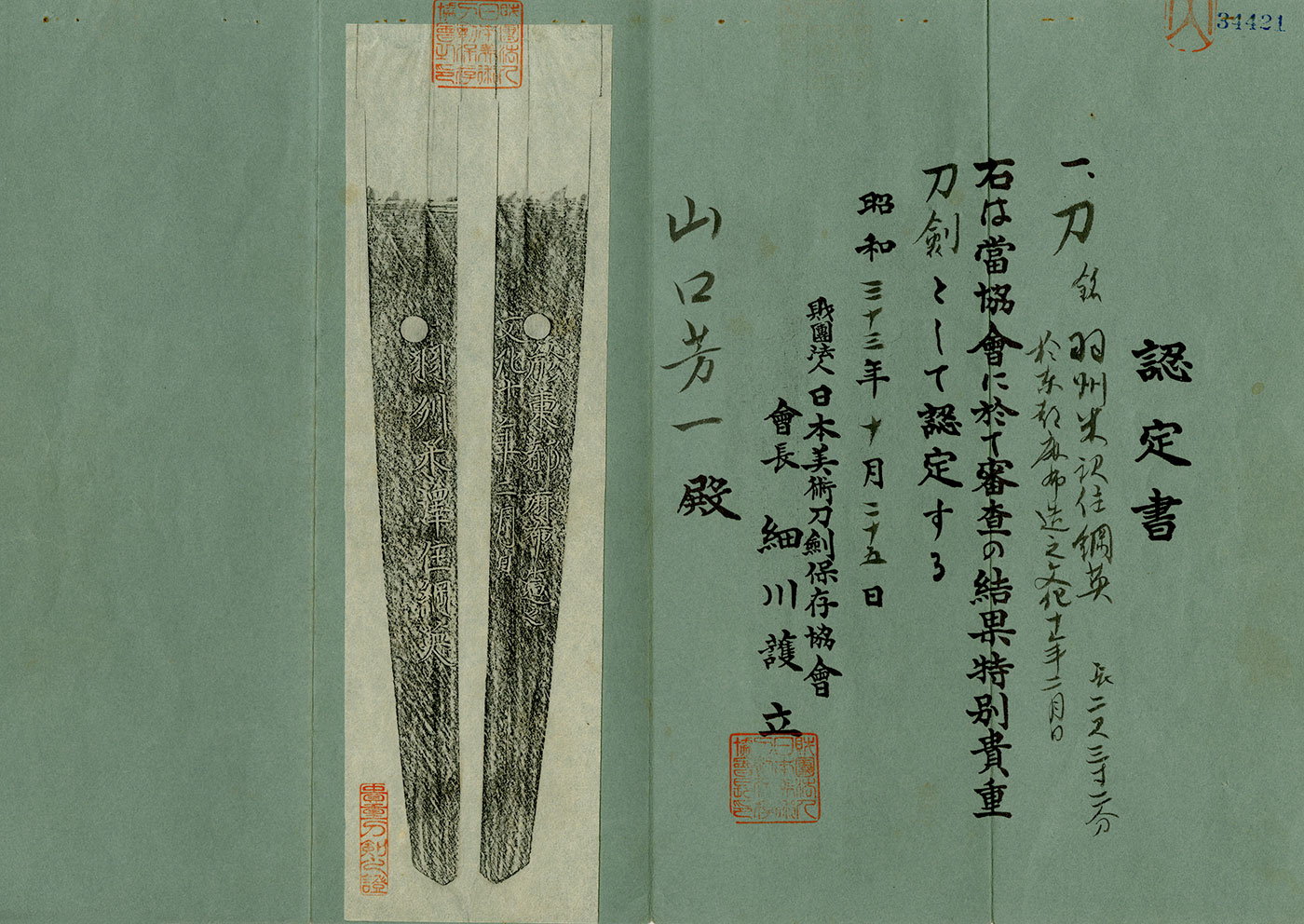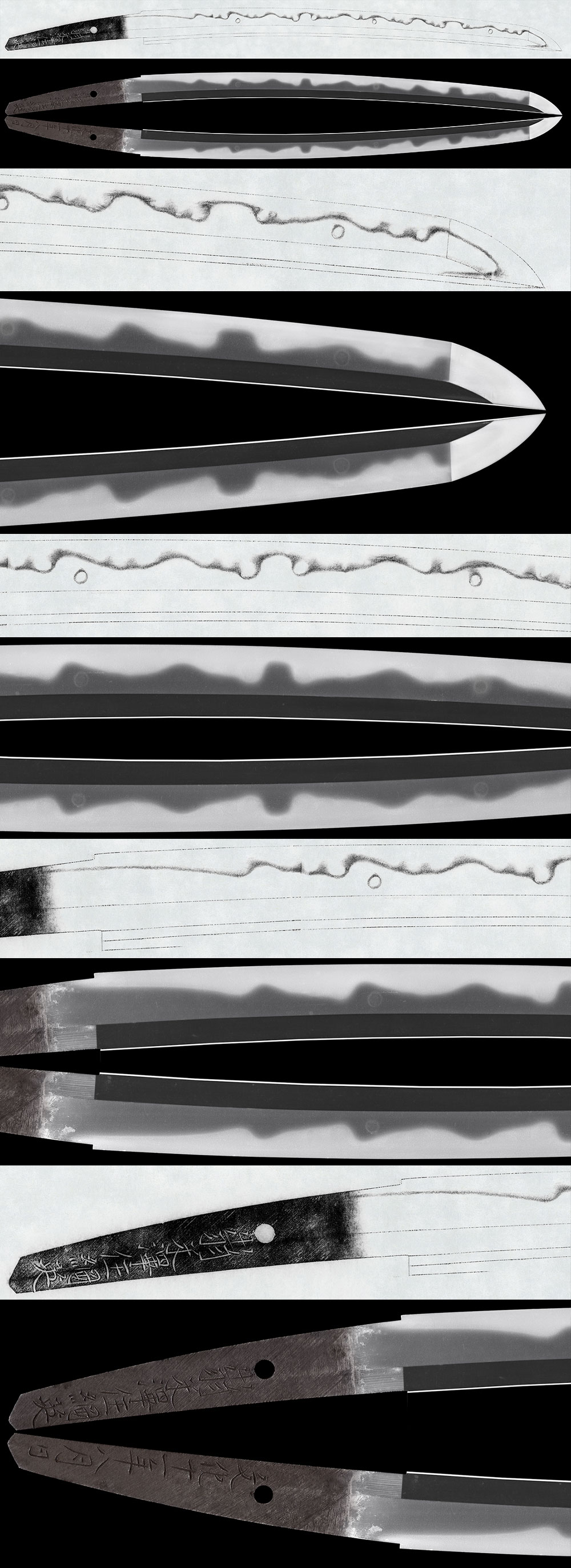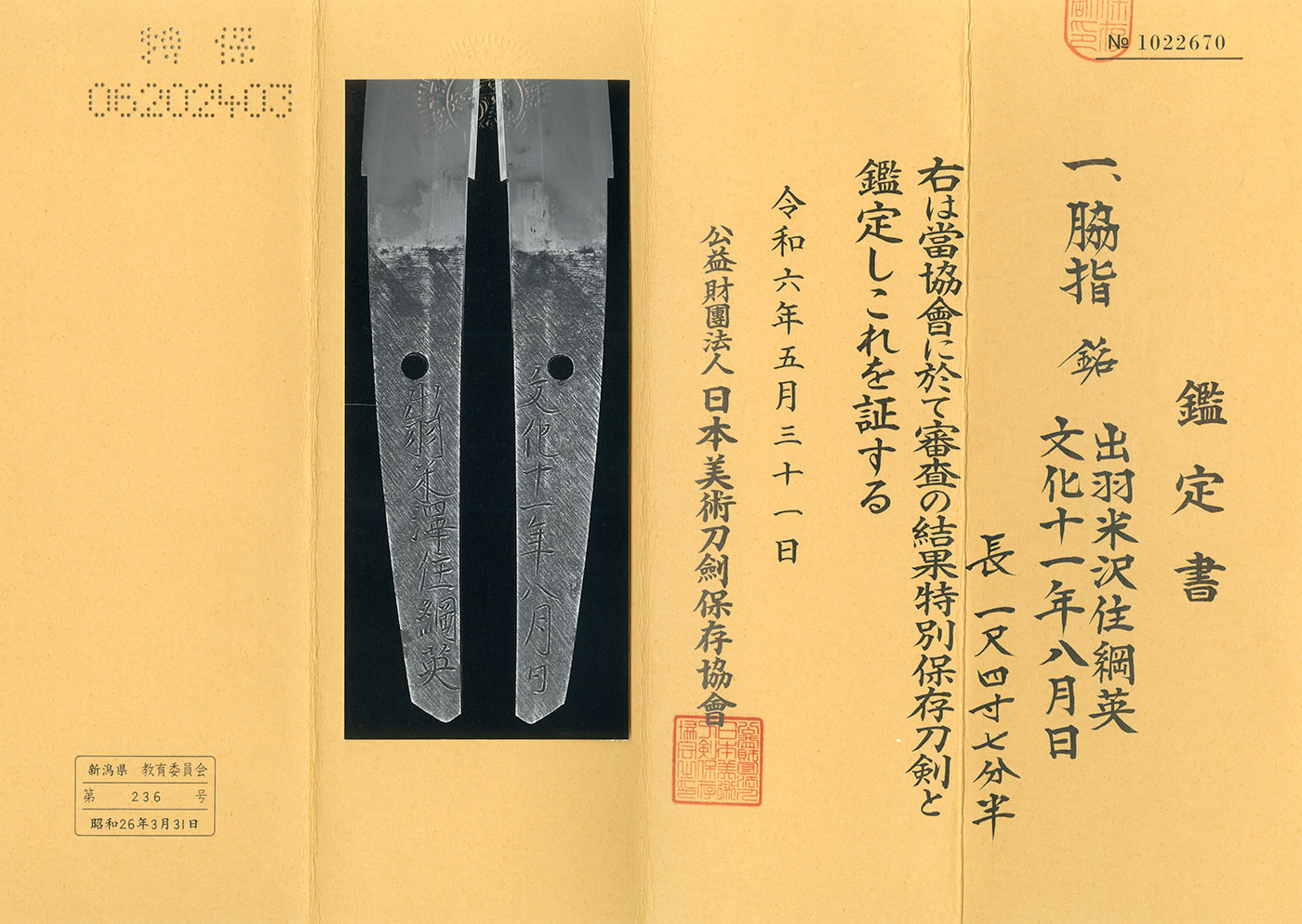Description
Dai Sho :
———————
Dai : Katana in Shirasaya with Koshirae(NBTHK Tokubetsu Hozon Token) (NBTHK Tokubetsu Kicho Token)
Signature: Ushu Yonezawa ju Tsunahide
Bunkyu 10 Nen 2 Gatsu Hi Oite Tobu Aso Zo Kore
(February 1813, made at Toubu Asou)
羽州米沢住綱英
文化十年二月日於東部麻生造之
Sayagaki by Kansan Sensei:
Kashu Yonezawa ju Tsunahide
Made in February of Bunkyu 10
Blade length: 2 shaku 3 sun 2 bu
Auspicious day of early spring, Showa Kōjutsu (1930)
Shinshinto: Jyo Saku: Musashi
We divide 4 sections for each sword as Saijyo Saku, Jyojyo Saku, Jyo Saku and Regular Saku.
This piece is ranked as Jyo Saku among Tsunahide’s works.
Habaki: Gold-covered double habaki
Blade Length: 2 shaku 3 sun 2 bu – 70.3 cm (27.68 in)
Curvature: 7 bu – 2.12 cm (0.83 in)
Mekugi Hole: 1
Width at Base (Motohaba): 3.01 cm (1.18 in)
Width at Tip: 1.96 cm (0.77 in)
Thickness of Rim (Kasane): 0.70 cm (0.28 in)
Sword Weight: 675 g
Era: Edo Period, Bunkyu 10 (1813)
Shape:A wide-bodied blade with a thick kasane.
Large hamachi, relatively deep curvature, and an extended kissaki form a well-balanced piece.
Jigane:Well-forged ko-itame hada with refined and clear mujihada appearance.
Hamon:Straight yakidashi from the hamachi, followed by a deeply nioi-based turbulent midare, ending in a rounded boshi.
Features: Tsunahide is believed to be the elder brother of Kato Tsunatoshi from Dewa province.
He was known for his mastery in creating turbulent hamon (tōranba).
Tsunatoshi occasionally imitated his brother’s style.
During the Shinshinto period, many swordsmiths competed to replicate the famous tōranba of Shinto-era Sukehira.
Koshirae:
Tsuba: Round iron tsuba with gold-covered rim, decorated with four Chinese sages in gold iroe.
Fuchikashira: Shakudo nanako base, inscribed with characters. Signed by Mitsusada.
Saya: Dark brown saya.
Menuki: Design of lions carved in high relief, with gold iroe.
———————
Sho : Wakizashi in Shirasaya with Koshirae (NBTHK Tokubetsu Hozon Token)
Signature: Dewa Yonezawa ju Tsunahide
Bunkyu 11 Nen 8 Gatsu Hi (August 1814)
銘:出羽米沢住綱英
文化十一年八月日
Sayagaki by Kansan Sensei:
Dewa Yonezawa ju Tsunahide
Made in August of Bunkyu 11
Blade length: 1 shaku 4 sun 7 bu 5 rin
Early spring of Showa Kōjutsu (1930) – Poem by Kansan
Shinshinto: Jyojyo Saku: Musashi
We divide 4 sections for each sword as Saijyo Saku, Jyojyo Saku, Jyo Saku and Regular Saku.
This piece is ranked as Jyojyo Saku among Tsunahide’s works.
Habaki: Gold-covered double habaki
Blade Length: 1 Shaku 4 Sun 7 Bu 5 Rin (44.7 cm / 17.60 in)
Curvature: 4 bu – 1.21 cm (0.48 in)
Mekugi Hole: 1
Width at Base (Motohaba): 3.04 cm (1.20 in)
Width at Tip: 2.18 cm (0.86 in)
Thickness of Rim (Kasane): 0.64 cm (0.25 in)
Sword Weight: 435 g
Era: Edo Period, Bunkyu 11 (1814)
Shape:Wide-bodied blade with thick kasane.
Retains the original hamachi, with a relatively deep curvature and extended kissaki.
A well-balanced piece.
Jigane: Well-forged ko-itame hada with refined and clear mujihada appearance.
Hamon:Straight yakidashi from the hamachi, followed by a deeply nioi-based turbulent midare, ending in a rounded boshi.
Features: Tsunahide is believed to be the elder brother of Kato Tsunatoshi from Dewa province.
He was known for his mastery in creating turbulent hamon (tōranba).
Tsunatoshi occasionally imitated his brother’s style.
During the Shinshinto period, many swordsmiths competed to replicate the famous tōranba of Shinto-era Sukehira.
Koshirae:
Tsuba: Round iron tsuba with gold-covered rim, decorated with four Chinese sages in gold iroe.
Fuchikashira: Shakudo nanako base, inscribed with characters. Signed by Mitsusada.
Saya: Dark brown saya.
Menuki: Lion design carved in high relief with gold iroe.
Kozuka: Shakudo base with a dragon swimming among waves and a warrior standing on a bridge with a horse, in high relief and gold iroe.
———————
Aoi Art’s Comment: This is a Daisho by Tsunahide of Yonezawa, Dewa province, with identical tōranba hamon.
Both blades come with koshirae and sayagaki by Kansan Sensei.
This type of Daisho is extremely rare, with both pieces believed to be made around the same time.
We highly recommend this fine set.
These swords were once registered as a Daimyo’s Daisho under Niigata Registration Numbers 231 and 236, both dated March 31, Showa 26 (1951), and were likely cherished as a pair even before the war.
Historical Context: The Bunkyu era was marked by exploration, such as Mamiya Rinzō’s expedition to Sakhalin and the discovery of the Mamiya Strait.
During this time, foreign powers began to pressure Japan to end its policy of isolation, leading to increased visits from overseas.
Katana and Wakizashi: NBTHK Tokubetsu Hozon Token
Katana: NBTHK Tokubetsu Kicho Token
Aoi Art estimation paper and whole oshigata













 日本語
日本語
